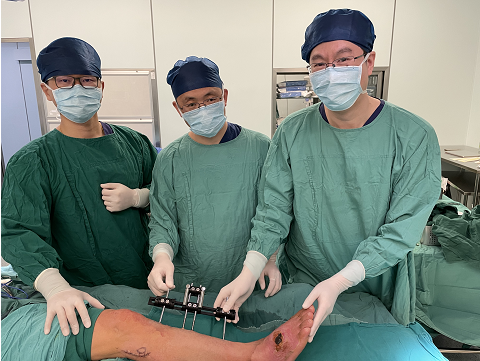- News
The Trauma Center at Shanghai General Hospital Used "Tibial Transverse Bone Transfer Technique" to Repair Chronic Wound of Diabetic Foot and Applied "Treat Injury with Injury" Technique to Rebuild Blood Circulation of "Old Rotten Foot”for the First Time
Link of the original article:
https://mp.weixin.qq.com/s/CaPPkgGoL55mrESmOouMZQ
The Trauma Clinical Medicine Center of Shanghai General Hospital repaired the chronic wound of the patient's diabetic foot by using the "transverse tibial bone transfer technique". By creating a small controlled bone trauma in the tibia of the affected limb and traction back and forth, the treatment team rebuilt the blood circulation in the distal part of the lower limb by "treating the injury with the injury", which led to the smooth healing of the skin ulcer that had plagued Mr.Wang for many years. This is the first case of "tibial transverse bone transfer technique" at Shanghai General Hospital.

In March, Mr. Wang's right foot had an ulcer, and the wound did not heal after a long-term treatment in another hospital in Shanghai. After consulting with relatives and friends, the patient came to our trauma clinical medicine center in Songjiang Campus for treatment.
Dr. Renguo Xie, chief surgeon and Dr. Song Gu, deputy chief surgeon of Trauma Center, conducted a comprehensive and detailed assessment of the patient including his blood sugar level, nutrition level and vascular patency of the affected limb. The resulting obstruction of blood circulation in the lower limb was the main reason for the ulcer wound not healing for a long time. To save the right foot, repairing the blood circulation in the lower extremity was key to treatment. After discussion, the expert team decided to perform "tibial transverse bone transfer technique" for Mr. Wang.
According to Dr. Song Gu, deputy chief surgeon of Trauma Center and head of MDT team of skin chronic wound at Shanghai General Hospital our, "tibial transverse bone transfer" means to create a small controlled bone trauma on the affected leg bone by taking a "small bone fragment", and then to remove the bone fragment in 1-2 months after the surgery. The bone fragment is slowly and continuously moved laterally and reciprocally for 1-2 months after surgery. As the biological tissue is slowly pulled, it generates a certain amount of tension, which stimulates the regeneration of capillaries and other tissues.
On the day of surgery, the surgical team first performed a minimally invasive tibial cortical osteotomy on his affected limb, took a small tibial cortical osteotomy piece, and then slowly moved the bone piece laterally using a specially designed lateral external fixation bone piece moving device. The entire procedure lasted about 1 hour. After the operation, the treatment team continuously retracted the bone fragment at a rate of 1 mm per day for several weeks, and then reversed the rate of 1 mm per day to restore the bone block to its original position, finally achieving the goal of "treating the injury with the injury" and improving and repairing the ischemia of the lower limb. After 2 months of treatment, the chronic wound on the back of Mr. Wang's foot healed smoothly.
According to Professor Haodong Lin, director of Trauma Center, diabetic foot ulcer has become one of the important causes of non-traumatic amputation in China. For patients with diabetes foot who meet the treatment conditions, "tibial transverse bone transfer technology" can induce the regeneration of microvascular network in their lower limbs, promote the healing of foot ulcer, and significantly reduce the amputation rate of patients with diabetes foot wound. In addition, this technique also has a good effect in the treatment of other types of chronic wounds of the lower limbs, such as severe traumatic wounds, arterial ischemic ulcer wounds and so on. This time, our hospital successfully carried out the first "tibial transverse bone transfer technology", marking a new level in the treatment of complex types of chronic skin wounds such as diabetes foot ulcer wounds.
Correspondent: Song Gu, Trauma Center, Yang Hu, Department of Publicity
Editor: Shishi Cai, Department of Publicity
